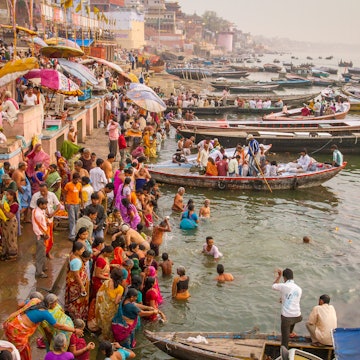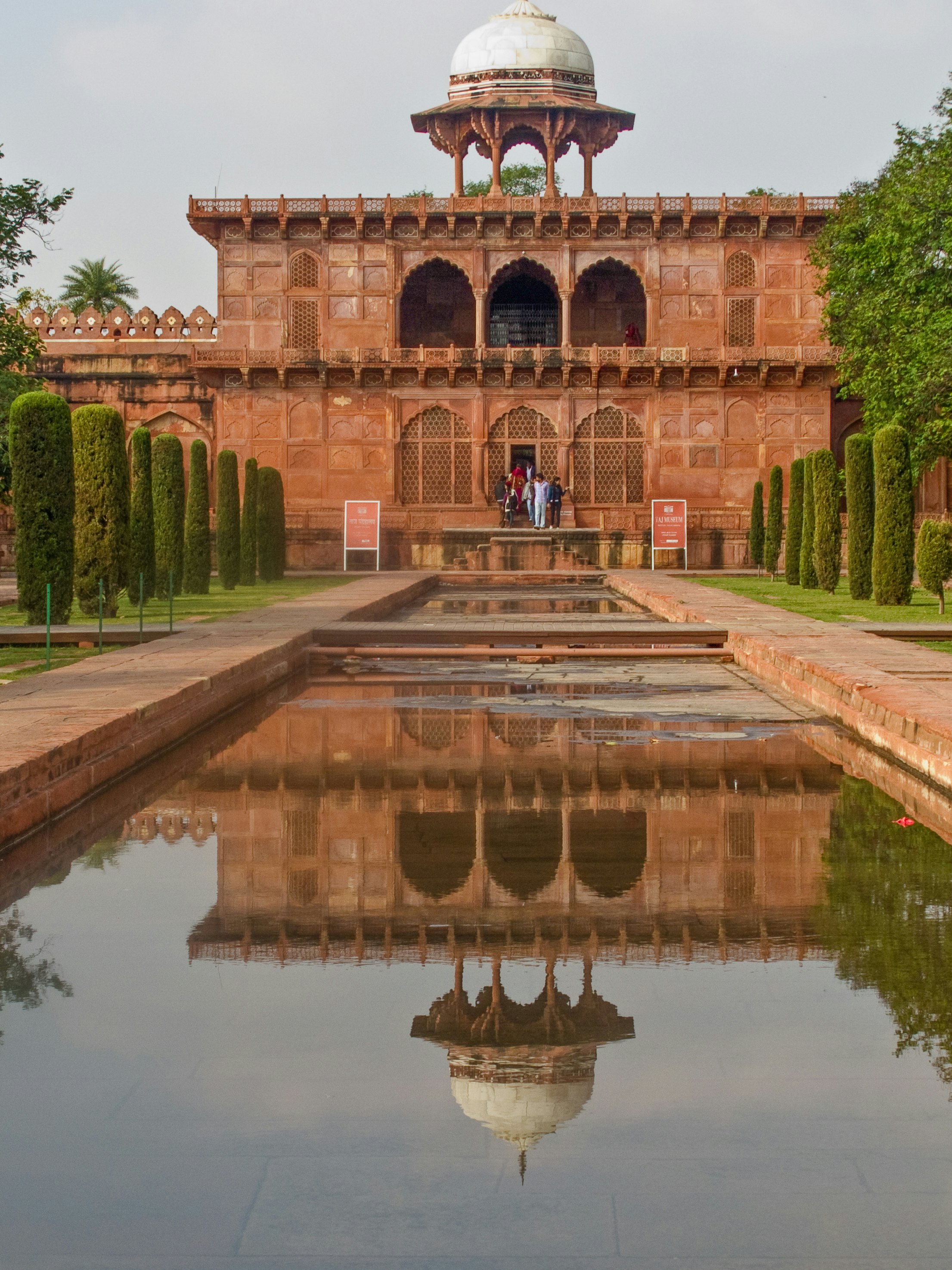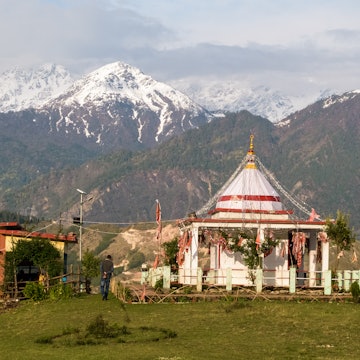

From why it was built to where you can stay nearby, we've got everything you need to know about visiting the incredible Taj Mahal. Sylwia Bartyzel
Are you India-bound and wondering if the Taj Mahal, a UNESCO World Heritage Site located in Agra, is worth the time, effort and crowds? In all honesty, skipping one of the most beautiful buildings in the world for any reason would be a travesty. Despite the infinite number of images scattered across the internet, nothing beats an in-person experience of the spellbinding all-marble wonder.
A heartbroken ruler’s fitting tribute to his dead queen, it remains an unsurpassed monument to eternal love. The Taj, as it is locally called, is a bucket-list favorite with good reason, so brace yourself for the droves queuing up alongside you to see this grand gesture from the 17th century.
The Taj Mahal memorializes Mumtaz Mahal, the third wife of Mughal emperor Shah Jahan, who died of childbirth-related complications in 1631. He commissioned the iconic edifice in 1632. It took eight years and the labor of more than 20,000 people to complete the dazzling marble mausoleum. The rest of the complex took another 14 years and was finally finished in 1653. Five years later, following a power struggle and bloody fratricide, his son Aurangzeb dethroned Shah Jahan and confined him to the Agra Fort for the rest of his life. He died in 1666 and was interred next to his beloved.

How do I get to Agra?
Agra is well connected by rail and road with Delhi. The easiest way is to take the 6:55am Taj Express, which reaches Agra in three hours. You can also pre-book a cab or hop into an Uber from Delhi (upwards of ₹2900 Indian Rupee/US$34). The airport receives domestic flights only from Mumbai, Hyderabad and Bengaluru.
Buy tickets in advance to avoid crowds
One of the ways to avoid the packed queues of people is to buy your tickets online. International visitors pay ₹1100 (US$12.70) for entry, SAARC and BIMSTEC visitors pay ₹540 (US$6.25), while Indian visitors pay just ₹50 (US$0.58). All visitors are charged an optional ₹200 (US$2.30) should they wish to enter the mausoleum. If you’ve made it this far, we recommend you do. Your ticket also includes a water bottle and shoe covers for the mausoleum.
The online purchase includes a nominal entry-fee reduction for a same-day visit at Agra Fort, Sikandra (Akbar’s Tomb) and Itimad-ud-Daulah. Ticket counters at the Taj Mahal open an hour before sunrise and close 45 minutes before sunset. It is closed on Fridays.

When is the best time to visit the Taj Mahal?
While you’ll never have the Taj completely to yourself, you will find a thinner crowd if you arrive when the monument opens, a half hour before sunrise. Consider a visit between February and April or September and November to avoid extreme temperatures, the notorious North Indian fog, smog, monsoon rains and the holiday rush.
Taj Mahal by moonlight
Night viewing of the Taj is possible on five days every month; on full moon night, and the two nights before and after. Only a limited number of people are allowed up to the main gateway for 30 minutes between 8pm and midnight. Book your slot well in advance for a stunning moonlight-bathed vista of the mausoleum.
Arriving at the Taj Mahal
Owing to extreme air pollution in Uttar Pradesh (which is discoloring the Taj Mahal), polluting vehicles are not permitted within a 500-meter (1640ft) radius of the monument. Parking facilities are found near Shilpgram (1km/0.6 miles) for the East Gate (where the queues are the longest), and at Amrood Ka Teela for the West Gate.
You can simply walk the distance along a paved road lined with hotels, souvenir shops and refreshment stalls on the eastern side, or hop into a battery-powered vehicle (also included in your ticket) for the short ride to and from both gates. The South Gate, nearest to the buzzing Taj Ganj neighborhood popular with backpackers and travelers on a tight budget, is exit-only at present.
Keep your passports handy as visitors must go through ticket and security checks at both gates. There are separate queues for men and women although foreign visitors can skip ahead due to their high-value tickets.
What not to carry
Large bags are not permitted. Free luggage check is available but it's best to carry essentials only (camera/phone, passport, water bottle, money) if you wish to breeze through. Tripods aren’t allowed either and almost everything else (including food, tobacco, lipstick, pens, books) will be confiscated.

What should I expect once I get there?
The main complex has two distinct sections. In the foreground is the charbagh, a walled garden layout typical of Central Asia, also known as a Mughal garden. Replete with fruit-bearing trees, and divided into neat fours by watercourses, it is said to represent paradise as referenced in the Quran. The mausoleum, at the far end, backs onto the Yamuna River beyond. An impressive main gate ushers you in from the forecourt.
This is where you’ll first set eyes on the luminous structure, framed dramatically against the sky, its watery likeness mirrored in a reflecting pool. The vision is every bit as stunning as the hype suggests, and you’ll need a minute to take in the iconic sight. Along with a sea of other awestruck shutterbugs and selfie-takers! Foggy days, a common occurrence from mid-December to mid-January, may sometimes mar this experience in the early hours. While here, take time to admire the imposing gateway’s splendid spandrels, inlay work and calligraphy. You may not get a chance on your return as the exit is through a side door.
Expect to be approached by eager guides, many of them imposters. Make sure to check their credentials (government-approved licenses) before you hire them. Alternatively, book ahead with a travel company or sign up for expert-led guided tours beforehand. Most of them are proficient in English. French, German, Italian, Spanish, Japanese and Korean-speaking guides can be arranged through your travel agency with prior notice. Audio guides are presently unavailable at the Taj.

Keep an eye out for design details
If you decide to visit the cenotaphs first, you can go straight along the row of tree-flanked fountains. Be prepared to find animated posers waiting their turn at a raised platform midway. This is a popular photo-op, made famous by sagely smiling world leaders and celebrities. You can join them or head on towards the mausoleum up ahead.
Your optional tickets will be checked before the stairs leading up to the plinth (inaccessible by wheelchair). Look out for the High-Value Ticket Holder sign to the right. Once you make your way up the narrow flight of steps, linger a bit to admire the vaulted facades. Take a close look at the gemstone-embellished pietra dura scrollwork, and the jasper inlaid calligraphy around the arched recesses. Note how the font size increases with height to create a uniform look.
Inside, an elaborate false tomb, surrounded by a latticed marble screen and inlaid with semiprecious stones, marks the cenotaph of Mumtaz Mahal. It lies directly below the central dome. Beside it, offsetting the symmetry of the Taj, is the larger albeit less adorned cenotaph of Shah Jahan. The real graves are in a locked crypt below the main chamber and cannot be viewed. Afterward, make your way to the sandstone structure called jawab (answer) to the east of the Taj. It was built as a symmetrical response to the mosque on the opposite side and is also known as the mehman khana (guesthouse).

Learn more about the Mughals
Should you wish to roam the grounds first, make your way along the western edge to the small but excellent Taj Museum (free, 10am-5pm, Sat-Thurs). Look out for ivory portraits of Shah Jahan and Mumtaz Mahal, and the display featuring architectural drawings and Mughal-era coins. The celadon plates in the gallery to the right of the entrance were said to change color or shatter when in contact with poisoned food. Outside, at the corner to your left, is an often overlooked photo-op that provides a fine view of the Taj Mahal rising above a canopy of green trees. Carry on along this periphery for the mosque (entry restricted) and the cenotaphs.
Where to eat near the Taj Mahal
Food options around the Taj Mahal are limited, but there are a few tried-and-true spots to hit up.
Yash Cafe: An oldie, oft-visited for desserts and coffee, this eatery is very affordable and within walking distance from Shilpgram parking (East Gate). Especially great for an early breakfast as it opens at 7am.
Shankara Vegis: Also a wallet-friendly option, this vegetarian spot in Chowk Kagziyan offers great thalis along with a rooftop view (and super friendly owners).
Mukeem Biryani: A local favorite for your biryani cravings; expect spicy and fragrant food.

The best views of the Taj Mahal
There’s every chance you'll want more of the Taj Mahal before you leave Agra and there are some excellent vantage points to view the stunning monument. This is also another chance for those (unbelievable as it sounds) wholly unimpressed with their first visit. A different perspective, mostly away from the crowds, might bring on a change of heart!
Mehtab Bagh, a Mughal garden on the north bank, provides the closest view from across the Yamuna. Visit at sunset to watch the play of fiery colors on its gleaming marble.
The rooftop cafés at Joey’s and the Saniya Palace Inn in Taj Ganj offer great views of the Taj.
Experience Shah Jahan's later-in-life view of his monument to love from Agra Fort. The imprisoned emperor spent his remaining years here gazing out at his masterpiece (2km/1.2 miles away). Plan for sunrise views from Khas Mahal and Musamman Burj.
Take a cycling tour or auto rickshaw ride through Agra’s rural surroundings to see the Taj silhouetted against lush farmlands.
Book a high-tea experience with Ekaa Agra and enjoy views of the Taj as you sip and savor.
What are accommodation options in and around Agra?
Agra offers a range of accommodations across the price spectrum. The luxurious Oberoi Amarvilas and the economical Joey’s Hostel are both located in bustling Taj Ganj and offer stunning views of the mausoleum. The colorful Coral House, a comfortable homestay in the same neighborhood, is another affordable option.
If you’re looking for some peace and quiet, Ekaa Villa and A Dog’s Story on Fatehabad Rd are good choices. Quieter still is the Mela Kothi-Chambal Safari Lodge, a family-run rewilded eco-lodge an hour’s drive from Agra.
















